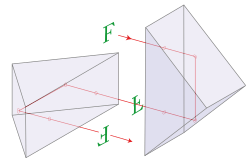Binoculars
Binoculars are a kind of tool that lets people see far-away things more clearly. The technology is called optics. Binoculars are made of a pair of matched telescopes which are held in front of the user's eyes.
The two telescopes of the pair have lenses that focus light and magnify the image. When someone looks through the binoculars at a far-away object, they can see details.
Early binoculars had two Galilean telescopes without prisms. Today most have prisms inside, which fold the light path to shorten the length of the tubes. That is why a binocular is shorter than standard telescopes of similar power.
Binoculars were invented in the 17th century. They allow a telescope user to use both eyes. The Royal Navy used single telescopes, but now all ships have heavy binoculars. Heavy ones can be mounted on swivels to scan the horizon. Binoculars are also standard issue in all armies. Night vision binoculars use photocathode electronics to intensify the image.
Binoculars are also used for theatre (opera glasses), birdwatching amateur astronomy, and generally watching the scenery.
Features
These features are present in some or all binoculars:
- Focussing is usually by turning knobs.
- Large binoculars have independent focussing for each 'telescope' (each side).
- Eye relief: Eye relief is the distance from the rear eyepiece lens to the exit pupil or eye point. It is the distance the observer must position his or her eye behind the eyepiece in order to see the image. The longer the focal length of the eyepiece, the greater the eye relief. Binoculars may have eye relief ranging from a few millimeters to 2.5 centimeters (1 inch) or more. Eye relief can be particularly important for eyeglass wearers.
- Range finding. Many binoculars have range finding reticle (scale) superimposed on the view. This scale allows the distance to the object to be estimated if the object height is known.
- Image stabilisation. On top-range models, by electronics.
- Optical coatings
- Anti-reflective: not just relections off the front lens, but every lens and prism. Anti-reflective coatings reduce light lost at every optical surface through reflection at each surface. Reducing reflection via anti-reflective coatings also reduces the amount of "lost" light bouncing around inside the binocular which can making the image appear hazy (low contrast).
- Metallic mirror coating for its prisms.
- Warships in World War II used very large binocular naval rangefinders (up to 15 metres separation of the two objective lenses, weight 10 tons) for ranging gun targets 25 km away. Late-20th century technology made this application redundant (radar; laser sights; guided missiles &c).
- Modern military binoculars have filters that block laser weapons used against them. Some are specialised for night vision.
Binoculars Media
8×42 roof prism binoculars with rainguard and opened tethered lens caps
WW1 era Galilean type binoculars
Parameters listed on the prism cover plate describing 7 power magnification binoculars with a 50 mm objective diameter and a 372 foot (113.39 m) field of view at 1,000 yards (914.4 m)












